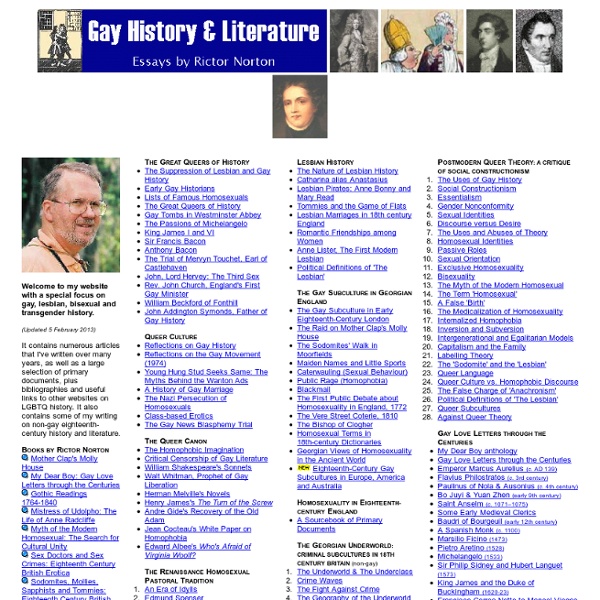



The Homophobic Imagination by Rictor Norton and Louie Crew The following essay is the editorial written for The Homosexual Imagination, a special issue of College English, the official journal of The National Council of Teachers of English, which was edited by Rictor Norton and Louie Crew in 1974. Part 1: Introduction Homosexual literature is written, read, criticized, and taught within a generally hostile environment. Although we may argue about the degrees of such hostility, and although we may debate its precise nature with regard to different kinds of repression, suppression, and oppression, this pervasive hostility is nevertheless an indisputable fact. To recognize this is to appreciate the sociology of literature. Many contemporary manifestations of the homosexual imagination are clearly political in import, as in Jonathan Katz's documentary drama Come Out! Part 2: Literature and Homophobia The term "the homosexual imagination" sounds like an erotic philosophy. Part 3: Scholarship and Homophobia
"Born Eunuchs" Home Page and Library The willingness to engage in homosexual activity (particularly intergenerationally) was widespread among men in the ancient Mediterranean region. Women and boys were considered equally tempting sex objects for ordinary men. Therefore, homosexual activity could not have provided a means of distinguishing a minority of men as "gay" the way we do in the modern world. However, the ancients did differentiate based on an unwillingness or incapacity for heterosexual sex. Certain men were known to fundamentally lack arousal for sex with women, and men of this kind were distinguished from the majority of ordinary men on that basis. Natural and man-made eunuchs co-existed as distinct categories for at least a thousand years, from the first-reported mass castrations about 600 BCE until 400 CE, when the classification of "natural eunuchs" was essentially made obsolete, and only the artificial type were identified as eunuchs anymore. email: aquarius@well.com visitors since 3/1/99 © 1999 Faris Malik.
Anne Seymour Damer Anne Seymour Damer, née Conway, (8 November 1749 – 28 May 1828) was an English sculptor. Life[edit] In 1767 she married John Damer, the son of Lord Milton, later the 1st Earl of Dorchester. From 1818, Anne Damer lived at York House, Twickenham. Works[edit] Damer was also a writer, with one published novel, Belmour (first published on 1801).[3][4] Personal life[edit] "The Damerian Apollo". 1798 caricature of Anne Seymour Damer chiseling the posterior of a large Apollo. A number of sources have named Damer as being involved in lesbian relationships, particularly relating to her close friendship with Mary Berry, to whom she had been introduced by Walpole in 1789. A romance between Damer and Elizabeth Farren, who was mentioned by Thrale, is the central storyline in the 2004 novel Life Mask by Emma Donoghue.[9] References[edit] Seewald, Jan. External links[edit]
Rush Limbaugh Is Racist, Here Are 46 Examples Conservatives have claimed for a long time that Rush Limbaugh isn’t a racist, that this image of the conservative thought leader is an invention of the so-called “liberal media.” This list exposes that for the lie that it is. It is a selection of Limbaugh comments, largely from the last 5-6 years (Limbaugh has been on the air for decades, but only has been closely monitored since Media Matters’ launch in 2004). The list has been pruned of simply outrageous statements to reflect the more racist proclamations by this leading conservative. Limbaugh is not a fringe conservative media figure. Limbaugh is among the top 2-3 most listened to political figures in America, and was invited to be the keynote speaker at CPAC, the leading conservative gathering. 1 Limbaugh on Obama: “Halfrican American” [1/24/07] 2 Limbaugh on Obama: His “only chance of winning is that he’s black” [6/2/08] 3 Limbaugh on Jesse Jackson: Kerry camp got “a chocolate chip” [1/30/04] 15 Limbaugh photoshops Rep.
International Phonetic Alphabet (IPA) Origin The IPA was first published in 1888 by the Association Phonétique Internationale (International Phonetic Association), a group of French language teachers founded by Paul Passy. The aim of the organisation was to devise a system for transcribing the sounds of speech which was independent of any particular language and applicable to all languages. A phonetic script for English created in 1847 by Isaac Pitman and Henry Ellis was used as a model for the IPA. Uses The IPA is used in dictionaries to indicate the pronunciation of words. Where symbols appear in pairs, the one on the right represents a voiced consonant, while the one on the left is unvoiced. Download an Excel spreadsheet containing the IPA How the sounds of English are represented by the IPA Recommended books about phonetics and phonology Links UCLA Phonetics Lab Data IPA, International Phonetic Association Free IPA fonts
Charlotte Dillon's Home Page Christian Nightmares Georgette Heyer Discussion Lists - Home Pologne • Fanatiques, bêtes et méchants Ce sont des scouts qui ont dressé cette croix en bois devant le palais présidentiel, au lendemain de la catastrophe aérienne de Smolensk [le 10 avril dernier]. “Il s’agissait alors d’une décision spontanée. Mais il est temps de la transférer, elle suscite trop d’émotions”, estime Monika Suchan, de l’Union du scoutisme polonais. Des déclarations comme celle-ci ont mobilisé les défenseurs de la croix, qui se réunissent régulièrement devant le palais. Dans la nuit du 13 au 14 juillet, vers 10 heures du soir, nous y sommes. “Nous avons eu le président Lech, qui était un vrai Polonais et un vrai catholique, alors ils l’ont attrapé et ils l’ont assassiné. Une heure passe, quelques femmes disent le rosaire. Un homme en chemise cravate, d’une cinquantaine d’années, l’a entendue. “Dehors ! C’est alors qu'apparaît un homme blond d’une trentaine d’années. Au bout de quelques minutes, la discussion reprend avec animation. “Cette croix doit rester ici pendant un an. – “Pourquoi ?”
Storymind.com - Writing Software & Free Writing Resource for Novelists & Screenwriters